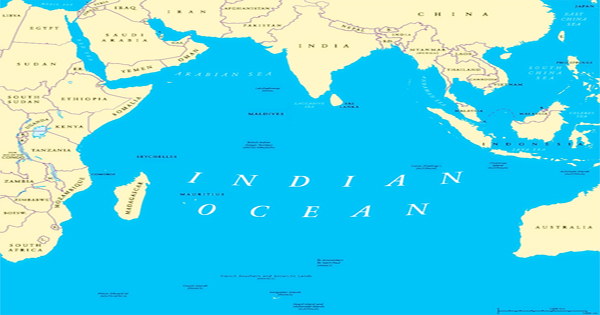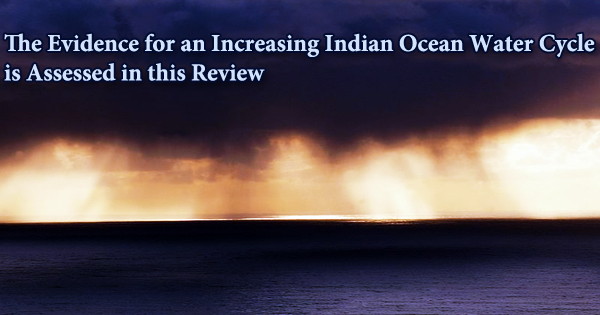Over the last 50-60 years, the Indian Ocean has warmed much more than other ocean basins. While temperature variations in the Indian Ocean basin may be ascribed to human-induced climate change without a doubt, determining whether recent heat and freshwater changes in the Indian Ocean after 1980 constitute an anthropogenically-forced hydrological cycle shift is problematic. Natural fluctuations, regional-scale trends, a limited observational record, climate model errors, and the ocean basin’s complicated circulation all confound the evaluation.
The water cycle appears to describe the movement of water above, on, and through the Earth, and it does. However, far more water is “stored” for extended periods of time than actually moves through the cycle. The oceans are where the great bulk of the world’s water is stored.
About 321,000,000 mi3 (1,338,000,000 km3) of the world’s water supply is believed to be stored in seas, out of a total of 332,500,000 cubic miles (mi3) (1,386,000,000 cubic kilometers (km3)). That equates to 96.5 percent of the total amount of water on the planet. The oceans are also thought to contribute around 90% of the evaporated water that enters the water cycle.

A new review paper examines whether changes in the Indian Ocean’s heat and freshwater are consistent with the expected increase in rainfall as a result of anthropogenic global warming, or whether these changes are due to natural variability on multi-decadal and other timescales, as well as other factors.
That distinction has “big implications for climate risk assessment and for the densely populated regions around the Indian Ocean that are vulnerable to the effects of climate change,” says Caroline Ummenhofer, lead author of the paper, Heat and freshwater changes in the Indian Ocean region, published in Nature Reviews Earth & Environment.
According to Ummenhofer, associate scientist in the Physical Oceanography Department at the Woods Hole Oceanographic Institution (WHOI), the article pulls together diverse scientific skills, methods, and data sources to answer critical issues about climate change in the Indian Ocean.
“The many scientific groups must come together and have open talks about what we can learn from our data, how to compare apples and oranges, and how to bring all of this information together to gain a greater knowledge of the Indian Ocean system as a whole,” she says.
“Rather than rely on climate models that struggle to accurately represent the complex circulation, we look at many different observational records including measurements of sea level, and the ocean surface and subsurface temperature and salinity,” says co-author Janet Sprintall, a research oceanographer at the Scripps Institution of Oceanography, University of California San Diego.
More ice caps and glaciers occur during colder climate periods, and enough of the global water supply accumulates as ice to reduce the quantities in other sections of the water cycle. During hot weather, the opposite is true. Glaciers occupied almost one-third of the Earth’s landmass during the last ice age, resulting in seas that were 400 feet (122 meters) lower than they are now.
While some changes in the Indian Ocean appear to be a consistent response to anthropogenic global warming, “in general our ocean observational records are still far too short to distinguish the naturally driven variability from the human-made changes,” says Sprintall. “This indicates that we must continue to measure our seas, particularly below the surface, in order to better understand long-term changes and their causes, as well as to enhance our forecasting and reaction to them.”
In situ observations (including Argo floats robotically programmed to measure ocean temperature, salinity, and other properties; moorings; and buoys), remote sensing by satellites to measure rainfall and sea surface salinity, and improved numerica are all needed to quantify changes in the Indian Ocean heat and freshwater balance.
The economy, energy production and usage, health, recreation, transportation, agriculture, and drinking water are all affected by changes in the water cycle. Because their calcium carbonate skeletons include the chemical characteristics of former seas, corals constitute a major paleoclimate repository in the ocean, reflecting past climate and environmental circumstances.
“Corals are unique environmental archives that allow us to extend our understanding of Indian Ocean variability centuries farther back in time than the observational record,” says co-author Sujata Murty, WHOI adjunct scientist and assistant professor in the Department of Atmospheric and Environmental Sciences at the University at Albany, State University of New York.
“Corals give a long-term viewpoint that complements observations and remote sensing data, improving our knowledge of complex climate and ocean systems and our capacity to predict future changes in a warming world.”
According to the paper, “disentangling the effects of multi-decadal natural variability and anthropogenic change on heat and freshwater changes” in the Indian Ocean and the Maritime Continent region between the Indian and Pacific oceans requires maintaining and expanding current remote sensing, in situ observations, and a network of paleo proxies.
The Indian Ocean is “particularly susceptible to anthropogenic climate change,” according to the research, in part because it is bordered to the north by the Asian peninsula. This implies that heat from the Pacific Ocean entering the Indian Ocean via the Indonesian Seas will not be able to readily escape the basin.
The basin “could be a kind of canary in a coal mine,” says Ummenhofer, because those changes now being observed in the Indian Ocean also could happen in other oceans. “We can all benefit from having better observations and a better understanding of the ocean so that we can know whether the changes are a climate change signal or part of a natural cycle.”















